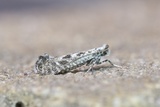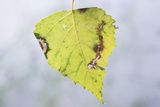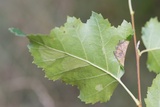Parornix betulae (Stainton, 1854) Species
Last modified: June 6, 2025, 10:37 a.m.
A fairly common species throughout Belgium.
Details
- Classification
- Family: Gracillariidae > Subfamily: Gracillariinae > Tribus: Parornichini > Genus: Parornix > Species: Parornix betulae
- Vernacular names
- Berkenzebramot (NL), Brown birch slender (EN), Birken-Randfaltenmotte (DE)
- First mention in Belgium
- Fologne E. 1863. Addenda au catalogue des Lépidoptères de Belgique. — Annales de la Société entomologique belge 7: 87–93. On page 92. view page
- Status
-
Native
Distribution
Imago
Forewing with greyish ground color; many small inconspicuous, whitish striae along the costa and some brown spots near the inner margin. Identification is difficult without knowledge of the larval hostplant because of the close resemblance with other Parornix species; a study of the genitalia might be necessary.
Caterpillar
Light green with light brown head; a row of four conspicuous dark brown spots on the thorax, the two inner ones larger than the two outer ones.
Mine
The first instar constructs a narrow gallery on the underside of the leaf, filled with brown frass. The next instar enlarges the gallery into a blotch in which gradually more spinning is attached causing the blotch to contract into a tentiform mine, which rather soon turns brown. Dark brown frass is deposited in a corner of the mine.
See also gracillariidae.net and bladmineerders.be.
Bionomics
When the caterpillar starts its free-living stage, it turns a leaf edge downwards and fixes this with silk to a fold under which it feeds further on the parenchyma.
Pupation in that leaf roll which falls to the ground litter during autumn.
The species hibernates in the pupal stage.
The adults rest in the foliage during the daytime but become active at dusk and during the night. They come to light.
Flight periods
Two generations a year from late April till June and from August till October.
Observed on
- Host plant (species):
- Betula pendula and Betula pubescens
- Host plant (genera):
- Betula
The caterpillars monophagously live on Betula species, mainly on Betula pendula, but also on Betula pubescens, B. alba and others.



